 |

|
May 2017 |
Saturday 27 May 2017
Uis - White Lady -Twyfelfontein: 164km, 4 hours
We get up early and have breakfast at 7 o'clock. After breakfast we drive
to the White Lady's rocks in the Brandberg massif. We drive
to a guide station. There we are coupled to a guid e
for 140 Namibian dollars, who takes us on the one-hour walk to the
rock drawings. The walk is beautiful and the guide tells everything there is
to know about nature, animals and plants. We see lizards, an eagle, beetles,
frogs, leopard tracks, snake and a porcupine. Also elephant tracks, who
sometimes come here. Fortunately not today, because in that case you can not
go to the engravings. At the end of the walk we have to climb a bit to get
to the rock paintings. There we catch our breath
e
for 140 Namibian dollars, who takes us on the one-hour walk to the
rock drawings. The walk is beautiful and the guide tells everything there is
to know about nature, animals and plants. We see lizards, an eagle, beetles,
frogs, leopard tracks, snake and a porcupine. Also elephant tracks, who
sometimes come here. Fortunately not today, because in that case you can not
go to the engravings. At the end of the walk we have to climb a bit to get
to the rock paintings. There we catch our breath ,
because the walk is quite strenuous and the sun is getting very hot fast.
The rocks were painted by the San people and are at least 3000 years old.
The polychrome drawings are somewhat younger. The central figure was taken
for a Mediterranean woman by the scientist Breuil in 1950, and so the
drawings became known as White Lady. Meanwhile, the present interpretation
is that it is a man (he has an decorated penis), a shaman or medical
practitioner who performs a ritual dance to get into a trans with which he
can heal the sick. There are many more figures around him, all of which are
explained by the guide. Then we take a look at the Königstein, the highest
mountain peak in the country and get on our way back. That goes a bit faster
and in 45 minutes we are back at the car. We then drive to
Twyfelfontein Country Lodge in around 1.5 hours. On the way we see a
large group of baboons trekking through the field.
,
because the walk is quite strenuous and the sun is getting very hot fast.
The rocks were painted by the San people and are at least 3000 years old.
The polychrome drawings are somewhat younger. The central figure was taken
for a Mediterranean woman by the scientist Breuil in 1950, and so the
drawings became known as White Lady. Meanwhile, the present interpretation
is that it is a man (he has an decorated penis), a shaman or medical
practitioner who performs a ritual dance to get into a trans with which he
can heal the sick. There are many more figures around him, all of which are
explained by the guide. Then we take a look at the Königstein, the highest
mountain peak in the country and get on our way back. That goes a bit faster
and in 45 minutes we are back at the car. We then drive to
Twyfelfontein Country Lodge in around 1.5 hours. On the way we see a
large group of baboons trekking through the field.
When we arriv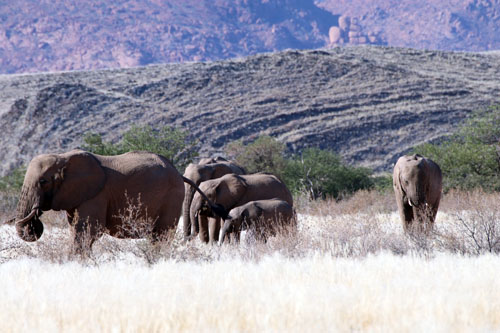 e
in Twyffelfontein we hear that there is a herd of elephants nearby. We can
go and see at once . A hotel clerk joins us in the car and leads us there
in a few minutes. The elephants are resting in the scrub. Still very nice.
We now know where they are and can return later in the afternoon.
e
in Twyffelfontein we hear that there is a herd of elephants nearby. We can
go and see at once . A hotel clerk joins us in the car and leads us there
in a few minutes. The elephants are resting in the scrub. Still very nice.
We now know where they are and can return later in the afternoon.
Later in the afternoon the Elephants get moving. From our room and balcony
we can see them with our binoculars. We go down there and see them from a
relatively short distance. After a while we go back to the lodge, but a
single elephant also comes to the lodge and moves into the hotel grounds.
The entire lodge is in turmoil, including the staff, because this is not an
every day event. The elephant keeps everyone busy for an hour and slowly
retreats.
In the evening we eat from the buffet. The food is mediocre. Not very
special, but the setting is beautiful.
Weather: sunny to 27 °.
Sunday 28 May 2017
After breakfast we drive to the
Living Museum of the
Damara. It is a kind of open-air museum wh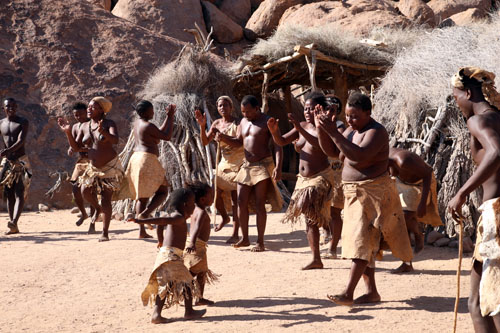 ere
the traditions of the Damara are kept alive. We are guided by a lady,
dressed only in a traditional skirt. We learn everything about their
forging, medicine, skin care, fireworks and games. After a fire is ignited
in a traditional way - by friction between a stick and a block - the whole
company starts to dance and sing. After all that, we also have a bushwalk on
which we will see the Damara hunting and gathering skills. There are two
toddlers in tow with us who want to be lifted up fo
ere
the traditions of the Damara are kept alive. We are guided by a lady,
dressed only in a traditional skirt. We learn everything about their
forging, medicine, skin care, fireworks and games. After a fire is ignited
in a traditional way - by friction between a stick and a block - the whole
company starts to dance and sing. After all that, we also have a bushwalk on
which we will see the Damara hunting and gathering skills. There are two
toddlers in tow with us who want to be lifted up fo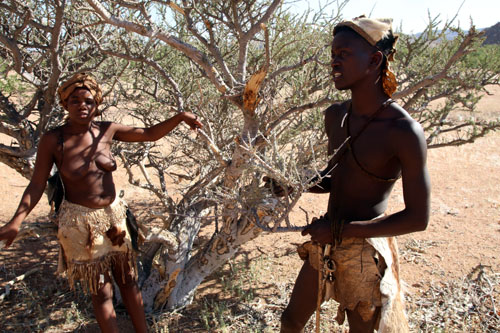 r
a hug at one point. After the tour we inevetibly come through the souvenir
shop and we are on our way to the next attraction. These are the so called
organ pipes. At the parking lot we have to register, pay N$ 100 and entrust
our car to the parking guard. The organ pipes are a rock
formation that has solidified about 120 million years ago in angular
columns, which resemble organ pipes with some imagination. A little further
on is the burnt mountain. It's a bit like a black colossus
in the bleeching sun.
r
a hug at one point. After the tour we inevetibly come through the souvenir
shop and we are on our way to the next attraction. These are the so called
organ pipes. At the parking lot we have to register, pay N$ 100 and entrust
our car to the parking guard. The organ pipes are a rock
formation that has solidified about 120 million years ago in angular
columns, which resemble organ pipes with some imagination. A little further
on is the burnt mountain. It's a bit like a black colossus
in the bleeching sun.
Then we drive to the Twyfelfontein itself. Twyfelfontein means doubtful
well, as the well gives water only now and then. On the way we see a
group of ostriches who are showing off running. Having arrived at
Twyfelfontein, we have to register again and get leave our car with the
guard. The obligatory tour takes about 45 minutes. Dion leads us along a
large amount of rock paintings by the San people. These again are about 3000
to 6000 years old. Especially many animal are
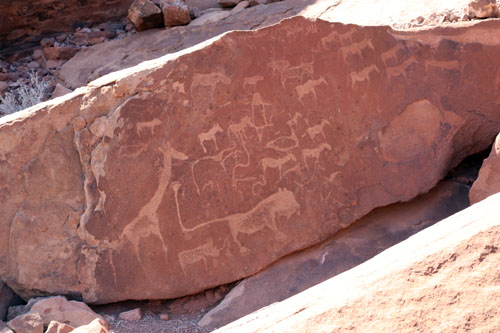 depicted.
Some paintings have a religious character, other more educational or
informative. There is something that you could call a map of water
resources. The sun is now high in the sky and it is very hot. Back at the
reception, we drink something and go back to the Lodge.
depicted.
Some paintings have a religious character, other more educational or
informative. There is something that you could call a map of water
resources. The sun is now high in the sky and it is very hot. Back at the
reception, we drink something and go back to the Lodge.
We are having lunch and afterwards we do not have much more to do. I go
swimming in the fresh swimming pool during the afternoon. In the evening we
dine at the buffet washed down with a Cape Gewürztraminer (Delheim).
Weather: Sun and 28ºC
Monday 29 May 2017
Twyfelfontein - Etosha: 343km, 4 hours
We drive via Khorixas to the Toshari Lodge just outside the Etosha
N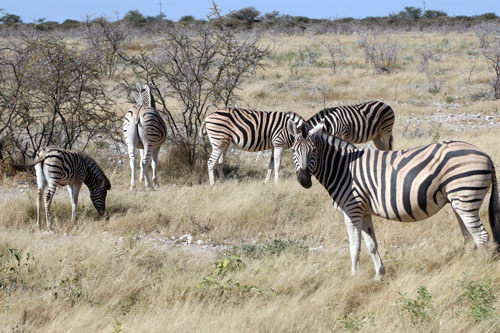 ational Park. In Khorixas we fill up and do some shopping. On the way we
encounter springboks that cross the road. We also see groups of baboons
trekking through the plains along the road. We make out a lost Oryx in
the distance. Drive to Khorixas on folows the gravel roads we are growing
used to. This time, however, with the a number of hills and sharp bends.
From Khorixas, the road is well paved and we can speed up. Our car has a GPS
tracker, which gives a beep when driving too fast. 60 km h for the city and
in NParks, 80 on dirt roads and 120 on paved roads. If we drive too fast we
are not insured. Now we can finally step on it.
ational Park. In Khorixas we fill up and do some shopping. On the way we
encounter springboks that cross the road. We also see groups of baboons
trekking through the plains along the road. We make out a lost Oryx in
the distance. Drive to Khorixas on folows the gravel roads we are growing
used to. This time, however, with the a number of hills and sharp bends.
From Khorixas, the road is well paved and we can speed up. Our car has a GPS
tracker, which gives a beep when driving too fast. 60 km h for the city and
in NParks, 80 on dirt roads and 120 on paved roads. If we drive too fast we
are not insured. Now we can finally step on it.
We reach the Toshari Lodge around 12 o'clock. We have lunch here in the
restaurant. The rooms are in small cottages on lodge's the grounds. We have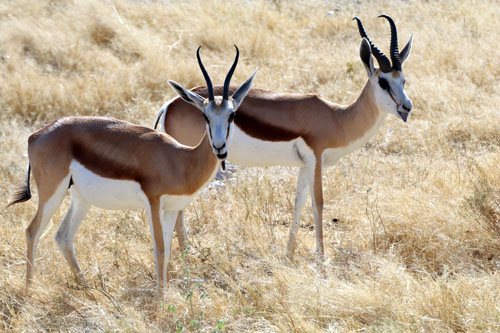 a nice
room. After lunch, we drive to Etosha National Park. The entrance is 40
minutes drive from the lodge. We pay N$ 80 for a day permit and N$ 10 for
the car. Soon we see herds of zebra and springboks. Here and there
another oryx. We visit a few waterholes, but that does not yield
much in the way of game spotting. Etosha National Park is relatively dry. There are, however, a large
number of wells. Some of them are artificially filled with solar powered water pumps,
feeding groundwater in the ponds. Animals have to drink, so
usually you can sit at a waterhole and wait for what is coming by, usually
in the early morning or late afternoon. After sunset you are not allowed to
drive in
the park. The zebras and springboks are very well represented in
Etosha based on what we can see today. At 4 o'clock we drive back to the
exit of the park. Tomorrow we will return and stay here too.
a nice
room. After lunch, we drive to Etosha National Park. The entrance is 40
minutes drive from the lodge. We pay N$ 80 for a day permit and N$ 10 for
the car. Soon we see herds of zebra and springboks. Here and there
another oryx. We visit a few waterholes, but that does not yield
much in the way of game spotting. Etosha National Park is relatively dry. There are, however, a large
number of wells. Some of them are artificially filled with solar powered water pumps,
feeding groundwater in the ponds. Animals have to drink, so
usually you can sit at a waterhole and wait for what is coming by, usually
in the early morning or late afternoon. After sunset you are not allowed to
drive in
the park. The zebras and springboks are very well represented in
Etosha based on what we can see today. At 4 o'clock we drive back to the
exit of the park. Tomorrow we will return and stay here too.
At the Toshari Lodge we drink a cocktail at the bar and dine from the
buffet. This are lots better than the one at Twyfelfontein. The meat is also
freshly prepared to order. I'm taking Kudu and Oryx.
Weather: Sun, 28 degrees
Tuesday 30 May 2017
Toshari Lodge -
Okaukuejo Camp (Etosha): 45km, 35 minutes
In Toshari we have a nice breakfast buffet. We walk all the way b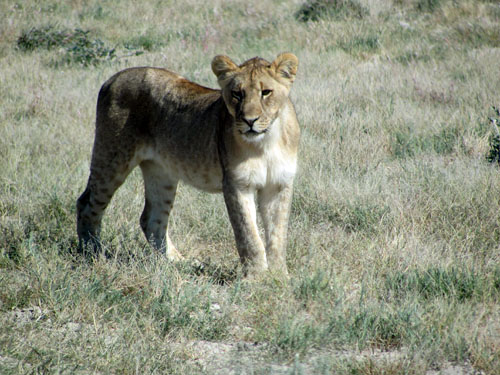 ack
to our cottage, get packed and leave for Etosha at 8 o'clock. At the
entrance ask for a permit for 2 nights in Etosha and continue to the MET
office in Okaukuejo camp. There we pay the permit. Check-in for the resort
is only available at 11 am. We drive to Okadengo water hole
north of Okaukuejo. We see a very large herd of zebras there. Some minutes
later we see cars stopping and people gesture us to get closer. Not without
reason: four lions are here taking a rest. We mak
ack
to our cottage, get packed and leave for Etosha at 8 o'clock. At the
entrance ask for a permit for 2 nights in Etosha and continue to the MET
office in Okaukuejo camp. There we pay the permit. Check-in for the resort
is only available at 11 am. We drive to Okadengo water hole
north of Okaukuejo. We see a very large herd of zebras there. Some minutes
later we see cars stopping and people gesture us to get closer. Not without
reason: four lions are here taking a rest. We mak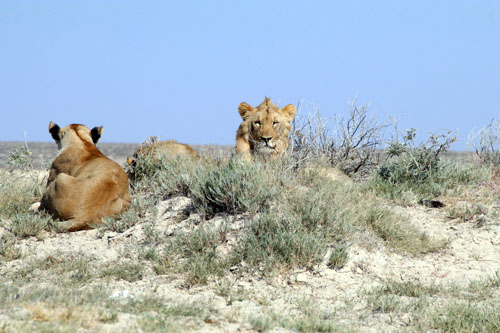 e
beautiful pictures of the three ladies and a gentleman. We drive further and
see giraffes, gnoes (wildebeest) and of course many zebras and springboks.
We drive further to Waterhole Adamax, but there is little
to see there. Then back to Okaukuejo, where we arrive at 12 o'clock. We
check in and have lunch at the buffet restaurant. After lunch we write some
postcards and put them in the mail. Then we get the key of our room. It's a
room in a block of seven. Far away from the reception, adjacent to the
campsite - that's a minus.
e
beautiful pictures of the three ladies and a gentleman. We drive further and
see giraffes, gnoes (wildebeest) and of course many zebras and springboks.
We drive further to Waterhole Adamax, but there is little
to see there. Then back to Okaukuejo, where we arrive at 12 o'clock. We
check in and have lunch at the buffet restaurant. After lunch we write some
postcards and put them in the mail. Then we get the key of our room. It's a
room in a block of seven. Far away from the reception, adjacent to the
campsite - that's a minus.
We rest, because we have been chasing wild animals for quite a long time
this morning. In the afternoon we go to the waterhole Salvadorana.
That is a nicely situated next to the Etosha pan, but there is nothing to
see in the way of game. On th e
way we have seen boks and giraffes. On the way back we see a striped jackal
at Waterhole Nebrownie.
e
way we have seen boks and giraffes. On the way back we see a striped jackal
at Waterhole Nebrownie.
Back in Okaukuejo we go to the waterhole of the camp around 17 o'clock. It
is still very quiet. The lights are slowly ignited. Two jackals appear, who
try to catch some birds, which they are not very good at. Then it is quiet.
We are going to eat at the buffet restaurant. The food is better than this
afternoon, but not as good as in Toshari. The organization is not very good
either. After dinner we walk back to the waterhole. We see a rhino taking a
bath. He relaxes bathing and then slowly returns into the darkness. We hear
lion roars in the distance, but they do not come to the water. A little
later, another rhino appears with a young one. Careful, they drink a bit,
but do not enter the water. Then they walk away and after a while they try
it again. Again, they do not go into the water and walk away. We have
already seen three of the big five.
Our room also features a mosquito net. We are in a malaria area, we started
taking the prophylaxis and use repellant in the evening.
Weather: Sun, 27 ° C
Wednesday 31 May 2017
Okaukuejo Camp - Onkoshi Camp: 176km
After breakfast we check out at the MET office and drive east through
Etosha. Etosha is huge in size: over 2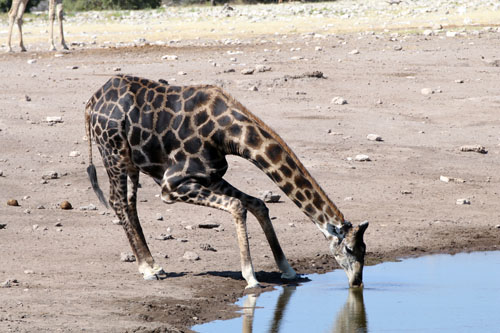 2
thousand square kilometers. That's 2/3 of the Netherlands! We are heading
towards Numotoni. A camp on the east side of Etosha. That is 130 km drive on
dirt roads. Sometimes reasonably good, sometimes littered with "washboards"
and holes. Just before Numotomi there is a waterhole where many wildlife
hangs out: Chadup. We drive there and are not be
disappointed. Two giraffes drinking, a group of zebras and impalas. To
see the giraffes see drinking is a speci
2
thousand square kilometers. That's 2/3 of the Netherlands! We are heading
towards Numotoni. A camp on the east side of Etosha. That is 130 km drive on
dirt roads. Sometimes reasonably good, sometimes littered with "washboards"
and holes. Just before Numotomi there is a waterhole where many wildlife
hangs out: Chadup. We drive there and are not be
disappointed. Two giraffes drinking, a group of zebras and impalas. To
see the giraffes see drinking is a speci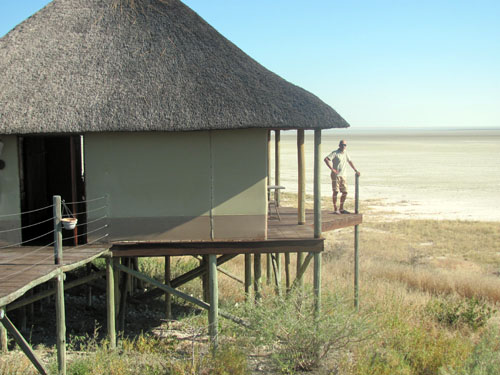 al
sight.
al
sight.
Then we continue to Namutoni. That is a fake castle set up
by the Germans here in the late 19th century. According to a plaquette, it
was stormed in 1904 by 500 Ovambo's, but the 9 (!) Heroic Germans held their
stand. They are commemorated with their names on the plaque. We have lunch
here before we start the last 45km to Onkoshi Camp. These take us along the
banks of the Etosha Pan, a huge dried salt plot in the middle of the NP. It
is over 6000 km² in size. The road to Onkoshi feels like
driving to the end of the world. Endlessly we drive, without meeting
anything or anyone, towards the camp at the edge of the pan. Onkoshi
consists of 17 canvas bungalows on poles overlooking the pan. The view is
very spectacular. Our bed is oriented towards the sliding doors, so from bed
we have this breathtaking view. There is also a restaurant, bar and ice-cold
swimming pool. We rest, take a dip in the pool and laze by the poolside. At
5pm we drink a cocktail at sunset. At 6pm it's dinner time. The food is nice
but not exceptional. At 7 we go on evening game drive. Our guide Barnabas
warns that the success of a gam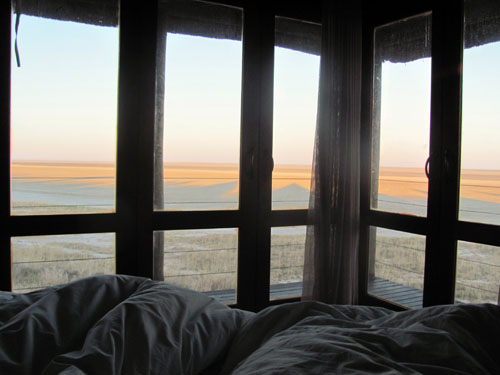 e
drive has all to do with a lot of luck. Nature does deliver on command. We
drive first some miles in the pitch darkness. On the way we encounter "bat
ear foxes". These are very small foxes that live from termites. They have
big ears to hear these insects walk. We drive to a waterhole and after a few
minutes we discover a spotted hyena. After that, four black rhinoceros.
That's spectacular because this rhino species is seriously threatened in its
existence. The rhinos drink and swim in the pool. Then we see an elephant.
It drinks a lot. Per nose full about 8 liters and 125 liters per day. The
rhinoceros are busy and then there is another elephant. Barnabas lights them
with a coloured floodlight. Making photos is very difficult in these
circumstances. It is getting cooler in the evening. From 28 degrees during
the day to 14 degrees in the evening. On the way back we see a spring hare.
e
drive has all to do with a lot of luck. Nature does deliver on command. We
drive first some miles in the pitch darkness. On the way we encounter "bat
ear foxes". These are very small foxes that live from termites. They have
big ears to hear these insects walk. We drive to a waterhole and after a few
minutes we discover a spotted hyena. After that, four black rhinoceros.
That's spectacular because this rhino species is seriously threatened in its
existence. The rhinos drink and swim in the pool. Then we see an elephant.
It drinks a lot. Per nose full about 8 liters and 125 liters per day. The
rhinoceros are busy and then there is another elephant. Barnabas lights them
with a coloured floodlight. Making photos is very difficult in these
circumstances. It is getting cooler in the evening. From 28 degrees during
the day to 14 degrees in the evening. On the way back we see a spring hare.
Back at our room we drink a beer and go under the warm blankets. At night it
gets very cold.
Weather: day 28 °, but at night it cools to 9 °
Thursday 1 juni 2017
Onkoshi Camp - Rundu:
426km 5 hours
We wake up to a beautiful view of the pan. It's cold. Fortunately, the
shower water is hot.
After breakfast we head on to Rundu. It's a long drive of
over 400km. Fortunately, almost the entire route is tarred and we can drive
120km/h outside the park. We make a first stop in Tsumeb. Here we drink
coffee at the Wimpy. Coffee culture has not yet been spent on the Namibians
yet. It is a busy town with many shops and gas stations. After the coffee
and using the ATM we drive on. The next place is Grootfontein. We want some
lunch here, but that's not an easy thing. Grootfontein is not blessed with a
lively restaurant scene. We end up with a sandwich at the Total gas station.
Then the last leg to Rundu. Along the way are two checkpoints. One for FMD
control and a second by the ordinary police. After some questions about
origin and destination we can continue. At half past three we get near
Rundu. That too is a busy place with many shops, a hospital and even traffic
lights and roundabouts. Our lodge, the Tambutih, is on the Okavango River,
which is the border with Angola here. We can see the neighboring country
from our hotel.
The Tambutih Lodge consists of
cottages. We have a relatively large one with three beds and a huge
bathroom. Later in the afternoon we make a small walk to the river bank and
look out to Angola. Back, we drink coffee and put the tires on normal
pressure .
We drink an aperitif in the bar and dine at the hotel restaurant. The
kitchen is completely local. I'm taking a crocodile and Erik an Oryx. Then I
have a lemon pie and Erik a Mutili ice cream. Delicious.
Weather: Ice cold in the morning, but in the morning it warms up to 27 ° C.
In the evening it cools down to 17 ° C
Friday 2 juni 2017
Rundu - Divundu: 207km, 2 hours
We have breakfast overlooking the river. Breakfast also has an Afr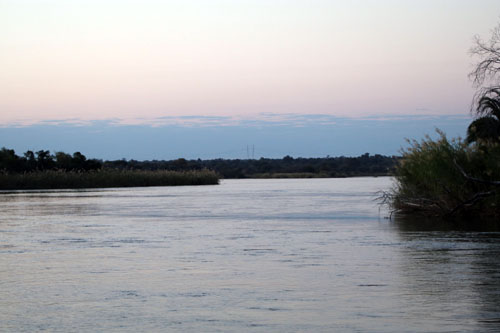 ican
slant. Erik has a local muesli kind and I have a Namibian pancake. For the
rest, breakfast is traditional. We are heading for Divundu.
It is a straight road of almost 200km. Along the way, we come across
miniscule hamlets, where people live in huts. We see the children walking to
school and the women get water and groceries. Men are standing by the road
to lift to somewhere else. After about 2.5 hours we are in Divundu and leave
the B8 towards the
Nunda River Lodge. We are stopp
ican
slant. Erik has a local muesli kind and I have a Namibian pancake. For the
rest, breakfast is traditional. We are heading for Divundu.
It is a straight road of almost 200km. Along the way, we come across
miniscule hamlets, where people live in huts. We see the children walking to
school and the women get water and groceries. Men are standing by the road
to lift to somewhere else. After about 2.5 hours we are in Divundu and leave
the B8 towards the
Nunda River Lodge. We are stopp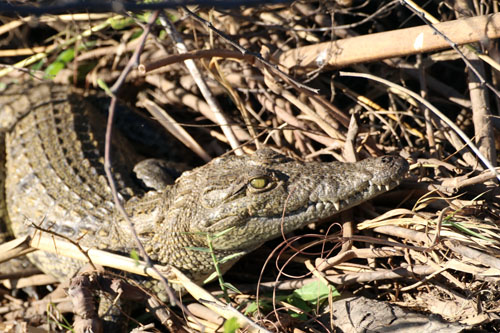 ed
for a police check and then on to the Lodge on the banks of the Okavango. We
are welcomed with a welcome drink. Lodge's facilities are explained. There
are game drives, river cruises, village visits and fishing-trips. We sleep
in a bungalow with a view on the river. The bungalow can not be closed off,
but there is a safe. We have lunch at 12 o'clock. It's an hour later here
(Caprivi time). After lunch, we laze about until 4 o'clock. From our balcony
we see about five hippos in the river. Then we take a wine on the terrace
and before starting on a sunset river cruise. We first go downstream and see
croco
ed
for a police check and then on to the Lodge on the banks of the Okavango. We
are welcomed with a welcome drink. Lodge's facilities are explained. There
are game drives, river cruises, village visits and fishing-trips. We sleep
in a bungalow with a view on the river. The bungalow can not be closed off,
but there is a safe. We have lunch at 12 o'clock. It's an hour later here
(Caprivi time). After lunch, we laze about until 4 o'clock. From our balcony
we see about five hippos in the river. Then we take a wine on the terrace
and before starting on a sunset river cruise. We first go downstream and see
croco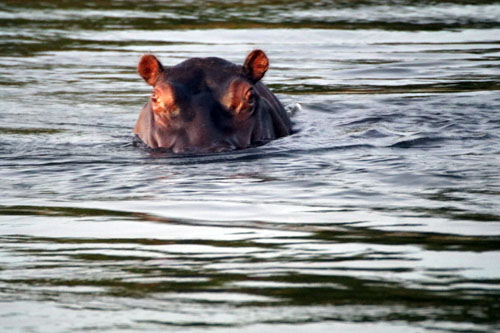 diles,
varans, cormorants, kingfishers, egrets, herons and much more.
diles,
varans, cormorants, kingfishers, egrets, herons and much more.
Then we turn around and go upstream. We see even more crocodiles, but also
the hippos we could see from our balcony. We continue to Popa Falls, a
waterfall, or rapids rahter in the Okavango. On an island in the rapids, we
can go on land to have a better view and photograph the rapids. Back on
board we go back to the lodge and see the hippos at a closer range.
We are back at 6.15 and at 7pm dinner is served. The food is good quality.
We start with a potato / blue cheese soup, then Kudu with potato croquettes
and finally ice cream.
After dinner we go back to our room.
Weather: Cold start of 16 degrees, but it warms up to 24 degrees.
Saturday 3 June 2017
After breakfast, we drive by car to the Mahango Core area of Bwabwata National Park.
The reserve is located along the river and many animals trek through to
drink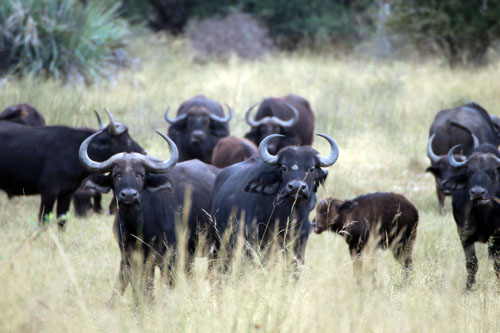 and bathe in the river. We see the Sable Antelope, a fairly rare antelope
species, which feels right at home here. In addition, we see many springbok
and impalas. Then we suddenly see a large group of buffalo. They look at us
with suspicion. The buffalo also belongs to the big five. We have seen 4 out
of 5 on this trip now. There are some calves among them. In the distance we
see even more buffalo in the water. White birds are sitting on their backs.
Further on, we see groups of wa
and bathe in the river. We see the Sable Antelope, a fairly rare antelope
species, which feels right at home here. In addition, we see many springbok
and impalas. Then we suddenly see a large group of buffalo. They look at us
with suspicion. The buffalo also belongs to the big five. We have seen 4 out
of 5 on this trip now. There are some calves among them. In the distance we
see even more buffalo in the water. White birds are sitting on their backs.
Further on, we see groups of wa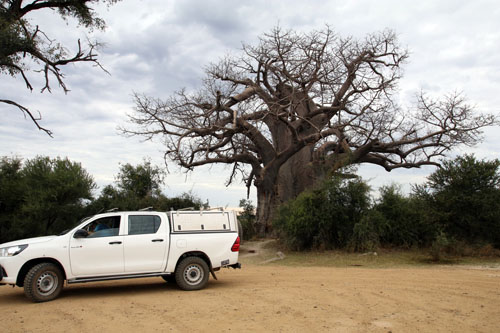 rthogs
looking for food. It looks like a family group with two adults and some
piglets. On their knees, they search for food. There are also Kudu's around
here, recognizable by the white stripes. These are more shy than the other
herbaceans. We drive to the huge Baobab tree from which we have a nice view.
Baobab trees are huge. They can reach a circumference of 34 meter . We see
ostriches and vultures, eagles and falcons. For a while we have the reserve
to ourselves. Only by the time we are leaving we see other visitors.
rthogs
looking for food. It looks like a family group with two adults and some
piglets. On their knees, they search for food. There are also Kudu's around
here, recognizable by the white stripes. These are more shy than the other
herbaceans. We drive to the huge Baobab tree from which we have a nice view.
Baobab trees are huge. They can reach a circumference of 34 meter . We see
ostriches and vultures, eagles and falcons. For a while we have the reserve
to ourselves. Only by the time we are leaving we see other visitors.
We then take the second route through the park, which is only suitable for
4WD. This route takes about 10km to a waterhole. Here we see a lot less
animals, but again the necessary hogs, kudu and boar.
Then it's time for lunch. We drive back to t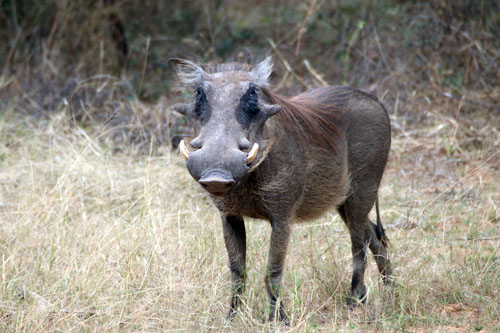 he
Lodge, after a brief visit to the village to refuel. The refueling takes a
lot of time, because the diesel does not flow well into the tanks. It has to
do with the double tanks we have.
he
Lodge, after a brief visit to the village to refuel. The refueling takes a
lot of time, because the diesel does not flow well into the tanks. It has to
do with the double tanks we have.
In the lodge we have lunch (it takes like forever before it's on the table)
and after that we take a rest. Around 3pm we go to the Buffalo Core area of
the Bwabwata NP on the other side of the Okavango River. This is much less
developed. It is one long road, which is getting smaller and the potholes
are getting deeper and the road surface sandier. After about half an hour we
turn around. The first animals we see only after twenty minutes. A couple of
buffalo skoot in front of our car . Also kudu's, hogs, boks and squirrels.
We return to the lodge.
Weather: Cloudy. Maximum 25 ° C
|
|
Other Travel |
|
| back | continue |